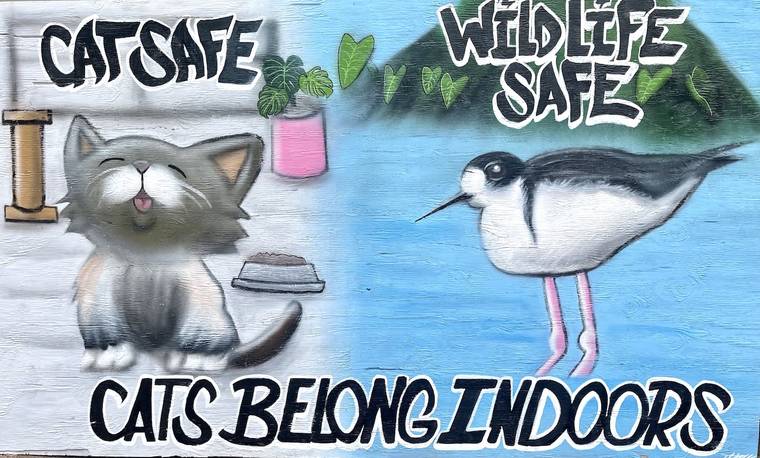LIHU‘E — Over the past two months, local artist Trysen Kaneshige has painted murals of Hawai‘i’s native waterbirds and seabirds at the office of Archipelago Research and Conservation in Hanapepe, and at his hale in ‘Oma‘o.
The project, supported by the County of Kaua‘i’s Rise to Work program and the Kaua‘i Wildlife Coalition, introduces awareness of endangered birds and the idea that both cats and birds are protected when felines are kept indoors.
“I am very thankful for the opportunity to be a part of this project. I’ve learned so much and had fun working with Helen and Andre (Raine),” Kaneshige said. “Before working with them, I was painting native birds for practice at home, and wanted to do more painting to challenge myself as an artist. Then this opportunity showed up.”
Kaneshige has a passion for and proficiency in art and creating messages to protect native birds on Kaua‘i. The protection aspect is mirrored by ARC.
“We were lucky enough to obtain funding for Trysen to join our organization, Archipelago Research &Conservation, through the Rise to Work program,” said ARC Science Director Andre Raine and Executive Director Helen Raine.
“We wanted to find a local artist who could provide a visual way to highlight how special our native wildlife is, and his artistic style was perfect for this messaging.”
Waterbirds like the ‘alae ‘ula (Hawaiian common gallinule) and koloa maoli (Koloa duck), as well as seabirds like moli (Laysan albatross) and ‘ua‘u (Hawaiian petrel), are an important and charismatic part of the Hawaiian culture, they said.
“Some of these birds are threatened with extinction across the state, but in Kaua‘i, we are lucky enough to be able to see them easily, at golf courses, parks and wetland areas,” Helen Raine said.
“These birds evolved without any mammalian predators on our isolated islands, so they do not fly away when confronted by an introduced predator, like a cat. The risk to Kaua‘i’s waterbirds and seabirds is magnified by the massive number of feral cats roaming the landscape and the fact that these vulnerable birds nest on the ground,” she said.
Helen Raine said outdoor cat colonies are problematic. These colonies maintain cats in poor living conditions, where they are at risk from car accidents, dog attacks and disease.
Grant Sizemore of the American Bird Conservancy said, “It’s safer for both the cats and the birds when all cats are kept indoors, on a leash or in a catio (fenced space). Cats can also spread a disease called toxoplasmosis to humans. It is particularly dangerous for pregnant women and their babies. In Hawaiian monk seals and dolphins, it is often fatal.”
Research published in 2020 indicated a surprisingly high prevalence of Toxoplasma gondii, the parasite that causes toxoplasmosis, throughout Kaua‘i.
The Kaua‘i Wildlife Coalition includes the American Bird Conservancy, Kaua‘i Albatross Network, Wildlife Friendly Business, Hanalei Watershed Hui, Hallux Ecosystem Restoration and Archipelago Research and Conservation.
Helen Raine said one of the central themes of this project is “Cat Safe, Wildlife Safe, and Cats belong indoors.”
“We love cats, and so do many people on Kaua’i,” Helen Raine said.
“But cats are one of the worst introduced predators in the world, and have been responsible for causing the extinction of multiple species. On Kaua‘i, they do huge amounts of damage to our native wildlife. They also spread diseases like toxoplasmosis, which are harmful to human health. This art project is a creative way to help get the message across that if cats are kept indoors, they are safe, and so is our native wildlife.”
Kaneshige’s work is portable, and will be exhibited in various locations around the island as COVID-19 restrictions are lifted. In the meantime, a virtual exhibition of the paintings can be found at youtube.com/watch?v=DsoLO3hJ1pg.
“It has been a great experience talking to Trysen about our native wildlife and the challenges they face, and then seeing him translate those ideas into artistic masterpieces,” Andre Raine said. “His art is a fantastic way to present the birds and their conservation challenges in a vibrant and creative way.”
•••
Stephanie Shinno, education and business reporter, can be reached at 245-0424 or sshinno@thegardenisland.com.




Mahalo Trysen!
I often encounter feral cats and the people who feed them along the shoreline of our estuaries and beaches.
Education is vitally important and trapping to relocate the cats, rats and chickens is the solution.
Cat lovers need to do the right thing for the rest of the animal kingdom and create REFUGE inland and away from waterways do that the toxic parasites that are known to spread endangered Monk SEALS and the flu viruses that jump from cats and chickens to humans are mitigated.
Education must be presented to all the senses for us to realize the importance of our relationship to the earth!!!
Art is the Magic medium!!!